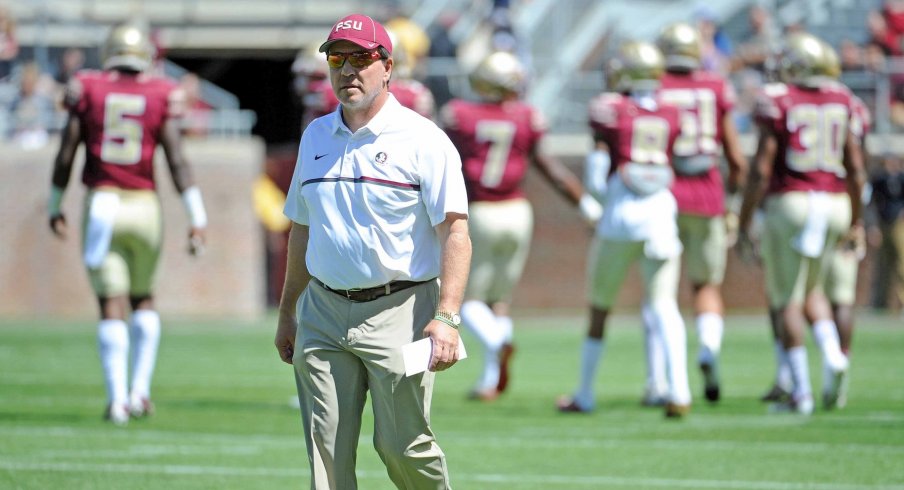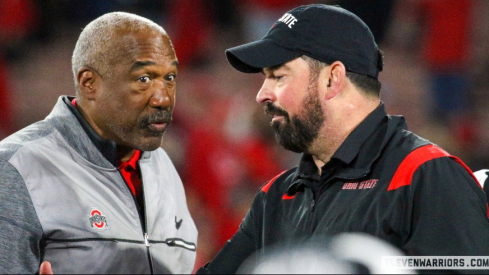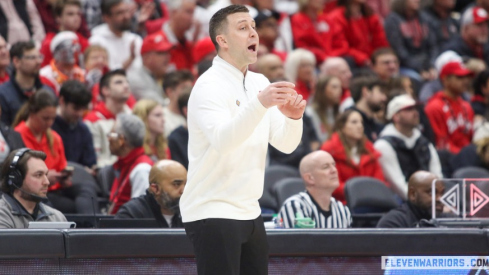As Bill Belichick would say, "We're onto Indiana."
That doesn't mean it's too early for us fans to began speculating on possible playoff opponents for the Buckeyes come New Year's Eve.
As with any season, Florida State sits atop the pre-season rankings with teams such as Alabama, USC, and of course, Ohio State. While losing tailback Dalvin Cook to the NFL Draft this Spring, the Seminoles are poised to make a national title run with seven returning offensive starters. Of those seven is redshirt sophomore quarterback Deondre Francois. While tossing for 3,350 yards and tacking on 20 touchdowns with only seven interceptions last season, Francois is poised to become even better this season.
Since Head Coach Jimbo Fisher took over the reigns at Florida State in 2010, the 'Noles have posted gaudy offensive numbers. The 2013 team that went on to defeat Auburn in the title game? Well, all 11 starters on that offense are now playing in the NFL. Fisher is one of the games best at developing talent.
Watching Florida State is like watching an NFL offense operate. It is very complex and puts a lot of the burden on the quarterback to make checks at the line of scrimmage. Head Coach of the Tampa Bay Buccaneers, Dirk Koetter, told reporters, "Heck, Florida State was probably installing more stuff per day [this spring] than we do." That puts in perspective the respect the pro game has for Jimbo's offense.
Stretch/outside zone
It all starts for the Seminoles with the run game. This past season they averaged 202.3 yards per game while averaging 5.08 yards per carry. That all starts with their 'Stretch' or 'Outside zone' play. The play was carried out in detail in my article last month while looking at Iowa's Offense. The play is meant to stretch the defense horizontally, hence the name "stretch," while opening holes for the running back to run.
Florida State will run this play from multiple personnel groupings, (11,12, 21), and a slew of formations. It's what every team does to protect their best plays. You have to dress them up with different formations and personnel groupings to keep the defense from keying on your core concepts.
The running back is reading the defensive end to the nose tackle on this play. If they tackle can reach the end, meaning the tackle has outside leverage, the running back will bounce the ball outside. If the end is running and has outside leverage on the tackle, the running back will turn his read back to the nose tackle.
If the center has outside leverage on the nose tackle, the ball carrier will 'bang' the ball in between the end and nose tackle. If the nose tackle has outside leverage on the center, then the ball carrier will 'bend' the run back behind the center into the backside of the defense.
Here is an example where the Seminoles run 'Stretch' out of the pistol with 11 personnel in the game. As you can see in the clip, the defense is getting stretched across the field and allows for a hole to open up for the running back.
This is an example of Florida State in 12 personnel running the play with the quarterback under center. The offense is in a double-wing alignment giving them the ability to run the ball to either side of the formation with a balanced formation. This time the defensive end is "reached" by the tight end and tackle so the running back 'bounces' the run outside.
Another reason this play can stay so versatile for the offense is they can build their quarterback sweep package off the same blocking principles. Here is an example of Florida State running Francois on a sweep play with the tailback lead blocking for him. The offensive line is still blocking the 'stretch' play up front but this time the ball is intended to hit outside with the tailback lead blocking for the quarterback.
Having a dual-threat quarterback in Francois, Fisher is able to dial up a very multiple run game. This is another example of Florida State having the defense out leveraged pre-snap and running the play for another nice gain.
counter
A good offense has more than one run scheme, as does Florida State. Another play they will hammer a defense with is the 'Counter' play. This was a play that was run heavily by the Buckeyes in the national championship game against Oregon.
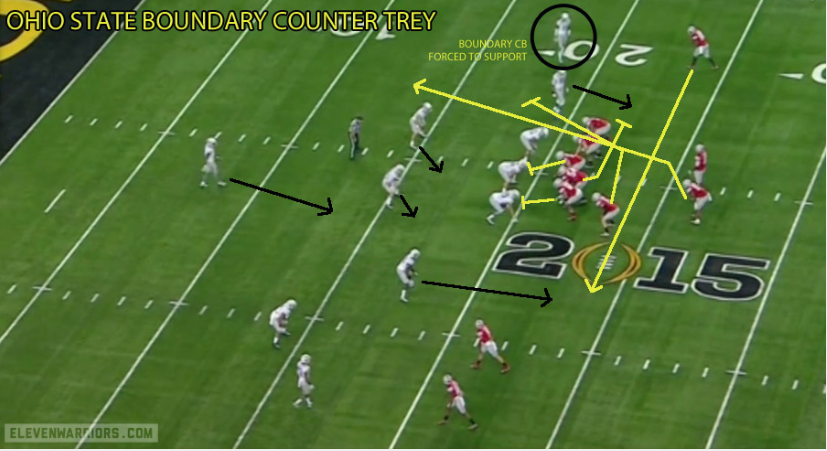
The play involves down blocks from the play side while the backside guard pulls around to kick out the defensive end with the tight end coming through to fill on the linebacker. What makes this play so prominent for Florida State is how they use a vast number of formations to run it.
The offense uses the "Leave 2" rule on the play side when blocking the counter scheme. This means to leave two unblocked players for the pulling players to block. In this diagram below that would be the E, the defensive end, and the W, will linebacker. The blocking back in this scheme helps give the offense an extra blocker to take care of the safety in case the play bounces outside like it often will when the defense is trying to spill the play.
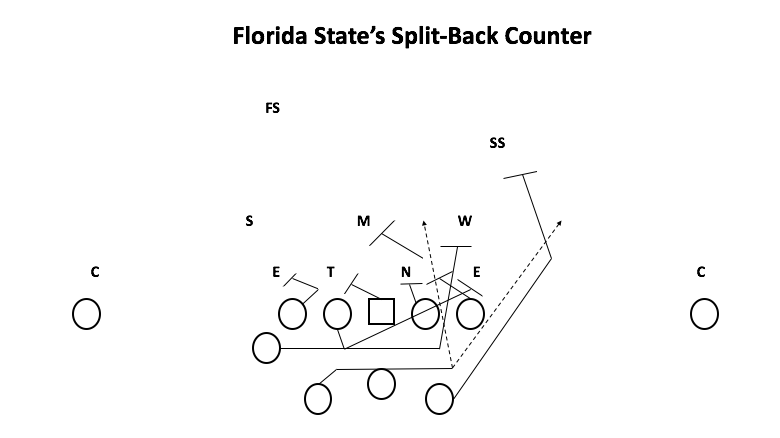
One thing Florida State does do is show a tendency of running their counter play from a 3x1 set meaning three receivers on one side with one receiver backside. This involves a tight end in a Y-Off alignment. With their quarterback sweep package coming from the same alignment/formation, it is tough to expect one or the other.
The clip below shows what can happen when the linebackers are shifted too far over to the field. It allows easy blocking angles for the play side and leaves a cornerback to take on the pulling tight end.
zone-extra
The third most common play seen from the Seminole offense is what they refer to as 'Zone-Extra'. In essence, it is an inside zone play for the offense that features an extra blocker to clean up any leakage that shows in a gap. It is their top red-zone run scheme.
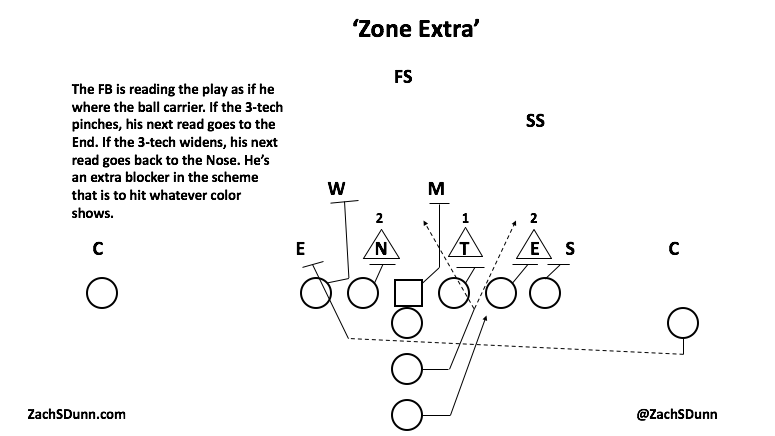
This was a play that received heavy usage versus Clemson this season. The offense comes out in their 21 personnel in a Pro-formation and tries to hammer the ball up the middle for a few yards. This is not a play that is meant to pick up chunk gains. It is meant to be a physical, up the middle play usually used in the red-zone and short yardage situations.
The offense uses a flanker to either come in motion to block the backside defensive end or they'll run him on a reverse path to try and hold the backside of the defense. Here is an example where they'll bring the flanker into block instead of run the fake-reverse.
personnel identification
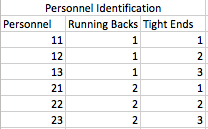
When listening to color commentators discuss personnel groupings such as 11 or 12, it is defined by how many running backs and tight ends are in the game for the offense. The first digit refers to the number of running backs in the game while the second digit refers to the number of tight ends in the game. So, 11 personnel is one running back with one tight end in the game. 12 personnel is one running back with two tight ends in the game. 21 personnel is two running backs with one tight end in the game and so on.
This helps the defense identify how they will respond with either their base package, nickel package, or even possibly a dime package. Personnel groupings are the first thing the defensive coaches are looking at when deciding their play call and who is on the field.
